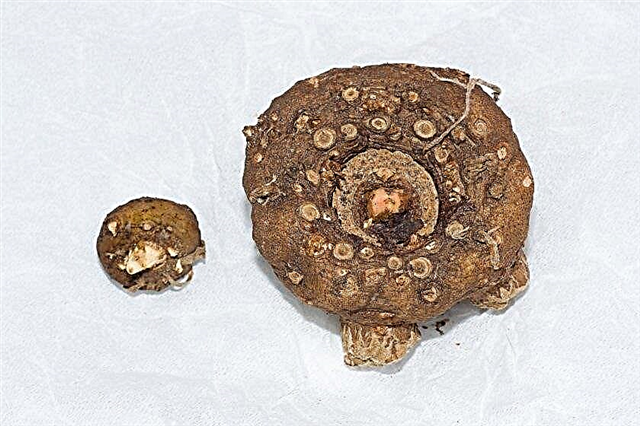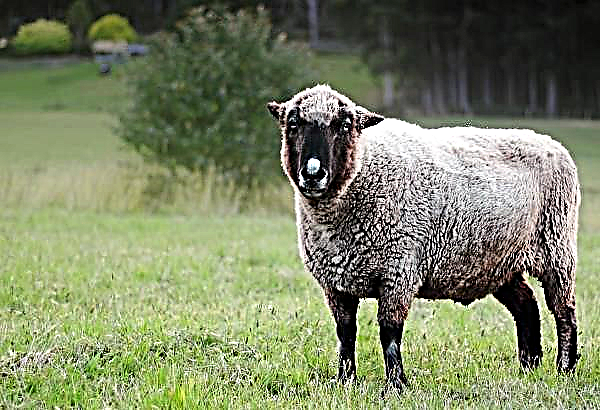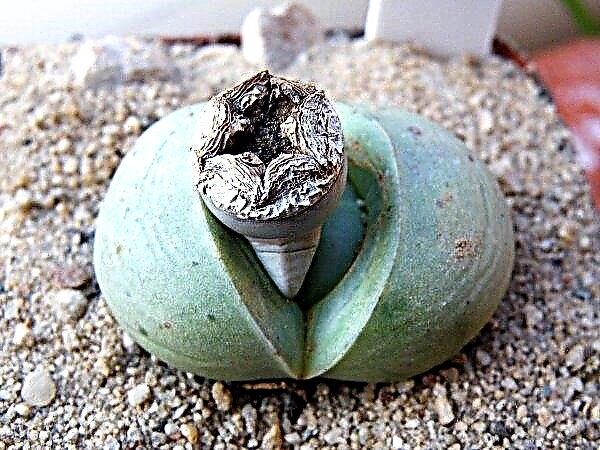Amorphophallus cognac will certainly be of interest to flower growers who appreciate unusual exotic plants. With comparative unpretentiousness in the care, the flower is highly decorative, therefore, it combines favorably with a wide variety of indoor vegetation, which can be seen by studying the following information about it.
Botanical description of the plant
This plant belongs to perennial tuber crops and in some countries (for example, Japan or China) is grown for consumption. Dried soups and properly cooked tubers really make tasty soups and side dishes, but in Russia and the neighboring countries, amorphophallus cognac remains only an ornamental plant, with a single inflorescence in the form of an upright, dark purple cob, which usually is about 50 cm long.
Around it is the same dark-purple petal veil, 25-30 cm long. At the top, the inflorescence is completely sterile and unable to form flowers. Therefore, all of them (both female and male) are concentrated in the lower part of the cob. The flower stalk is thick and straight, often reaches a height of 60 cm. The leaves on it are bright green, transversely dissected, with small notches at the end.

In the natural environment of growth, the diameter of leaf blades often reaches 1.3 m, but when grown indoors, they do not exceed 1 m. The diameter of the leaf petiole is about 8 cm, and in height it grows to 1 m. Petiole and peduncle are the same size and the same the same color: dark and light spots are scattered over the entire surface more than an olive shade, resembling the coloring of snake skin.
At the end of the season, the leaves begin to die gradually, and the next year they appear slightly higher and are characterized by a greater dissection. The underground tuber resembles a flattened, rather large ball with a diameter of 20-30 cm. In the upper part, it grows a lot of roots and individual children, with the help of which the plant reproduces.
Did you know? The first plants of the genus amorphophallus were described as early as 1692, and in 1834 they received the modern name, which is formed by several ancient Greek words: “amorpho” - formless; “Phallus” is the male genital organ. Most likely, this designation is associated with the external features of the flower.
The flowering of amorphophallus cognac lasts 14 days, and begins in March or April. All stages of its development exot takes place within six months and already in September goes into a state of rest (immediately after the death of the leaf).
Optimal conditions for growing at home
Given the exotic unusualness of amorphophallus cognac, it is not surprising that with home cultivation he needs to create the most suitable conditions, providing for the correct selection of the cultivation place and the subsequent competent flower care.
Location and lighting
After buying amorphophallus, cognac can adapt for a long time to new growing conditions, therefore, to help the plant in this, it is advisable to place the pot on a well-lit window sill, but without direct exposure to sunlight. An excellent solution for the flower will be a semi-shaded area near the balcony or windows, and even on the north side of the house.

Temperature mode
Amorphophallus does not have special requirements for room temperature, and it feels quite comfortable at + 17 ... + 25 ° C, with a decrease in these values to + 10 ... + 12 ° C during rest. In the summer, the plant can tolerate higher temperature values, but in the cold season the tubers should not be cold, otherwise this is fraught with the death of the whole flower.
Features of home care
Exotics care is quite standard and provides for timely watering, regular soil fertilization and flower transplantation when necessary. Each of these actions has its own characteristics, which you should definitely know about in order not to destroy amorphophallus.
Watering
Basically, the described plant needs moderate application of fluids, with a regularity of once every 2-3 days. At the same time, it is worth focusing on the state of the upper soil layer, allowing it to only dry out slightly during the period of active vegetation of the flower. When an inflorescence or leaf appears, the amount of irrigation fluid must be increased, while watching the top of the tuber with small roots: they should not be exposed, and if this happens you will have to add soil.
For irrigation, only soft water at room temperature can be used, so it is worthwhile to pre-filter or boil the tap liquid, additionally settling in the room for the next 2 days. Some gardeners add a few drops of citric acid or apple cider vinegar to 10 liters of liquid.
Important! One of the characteristic features of amorphophallus brandy is the poor moisture transmittance of its leaves, therefore, to maintain an optimal level of humidity, it is useful to periodically spray them from the spray bottle (at least once every two days).
When watering, do not pour liquid directly onto the tuber of the flower, as this will only contribute to the development of putrefactive processes. It is wiser to pour water in small portions along the edge of the pot, waiting until it begins to seep into the pan. At this watering can be considered completed, and it remains only to drain the excess water after 45-60 minutes. For hygienic purposes, it is possible to wipe the leaves of amorphophallus with a damp cloth, removing all excess dust from the plant, which only complicates the task of moisture absorption.
Air humidity
The described plant does not accept reduced air humidity in urban apartments, so for its good health you will have to maintain this value at the level of 70–80%.  To do this, regular spraying of the flower with warm water and placing next to it open containers with clean liquid will help.
To do this, regular spraying of the flower with warm water and placing next to it open containers with clean liquid will help.
Top dressing
Fertilizing amorphophallus cognac is especially important for the plant during the growing season, so the first top dressing is carried out already a month after the appearance of young sprouts. In the future, the frequency of nutrient intake is 1 time in 15–20 days, and complex mineral compositions in which a high phosphorus content is noted as a suitable composition (it is actively consumed by tubers during weight gain). The optimal ratio of phosphorus, potassium and nitrogen in this case will be 4: 1: 1, or at least 3: 2: 1.
With proper preparation, it is also possible to use natural organics in the form of rotted cow manure or bird droppings diluted in water in a ratio of 1:20 or 1:10, respectively. In any case, fertilizing should be done 15–20 minutes after the next watering, otherwise there is a chance to burn the roots.
Transfer
An amorphophallus transplant is performed almost every year, in early spring (with a growing point swelling). The new pot should be 2-3 times wider than the tuber itself, and its height may correspond to the diameter. Ceramic products are best chosen because they are more stable and absorb more moisture than plastic ones.

As for the optimal composition of the soil mixture, its main qualities should be friability and nutrition. The optimal finished option for such a soil is a substrate for aroid, although it is possible that they can independently prepare the required soil.
There are several possible options:
- a mixture of equal parts of fertile turf, leaf soil, peat chips, humus and coarse river sand;
- a substrate from a ready-made universal soil mixture for indoor plants, rotted compost (crushed dry manure), peat and sand, in a ratio of 1: 1: 1: 0.5;
- a mixture of garden soil and sand (4: 1) with the addition of useful superphosphate (20 g per 3 l of the finished soil mixture).
Important! It is advisable to spill the prepared soil mixture with a solution of potassium permanganate or calcine in the oven, thereby relieving the soil of possible pathogens.
The process of flower transplantation provides for the following actions:
- Covering the drainage holes of the landing tank with a ceramic shard, fill it 1/3 with coarse sand, crumb brick and fine expanded clay, which will make up the required drainage layer.
- Then, pour the prepared substrate from above so that it reaches half of the planting pot.
- Carefully remove the plant from the previous container, carefully inspect and remove all dried and rotten roots. Damaged places on the tuber itself will also have to be cut to healthy tissues, and the places of the cuts should be treated with iodine, brilliant green or crushed charcoal. Over the next two hours, the plant must be left to dry the treated areas.
- After the specified time, organize a small depression in the soil and, filling it with sand, immerse the lower third of the tuber inside.
- Add soil around the edges, periodically shaking the pot slightly. The growth point of the flower should remain above the surface of the earth.
- Lightly moisten the plant and take the pot to where the scattered sunlight will fall on it.

In the future, during the season, you need to gradually add earth to the pot, as the daughter parts and new roots will form closer to the top of the mother plant.
Did you know? Powerful tubers of the described flower are actively used for medical purposes, but mainly for the preparation of antidiabetic drugs. In addition, the gelatin-like substance present in them is the main constituent part of tofu cheese.
Plant propagation methods
When grown at home, amorphophallus does not produce seeds suitable for further propagation of the plant, so the only chance to get new copies is to root the children (daughter tubers) that have appeared on the plant. In case of emergency, you can divide the parent tuber itself, but only if there are several growth points on it.
In the latter case, there is a high probability of development of putrefactive processes, therefore, if possible, it is better to wait for the formation of processes. Reproduction of amorphophallus by offspring is performed in the autumn, when the flower begins a dormant period.

It provides for the following actions:
- Carefully remove the tuber from the ground and sift the substrate in search of offspring.
- Dry the parts found and store them. Daughter siblings can be stored all winter, but only in a dry and relatively warm room, with temperature values ranging from + 10 ... + 15 ° C.
- With the advent of spring, prepare suitable planting tanks, fill them with one of the above options for the substrate and drop off the delenki. Caring for them is based on all the same actions as when growing adult plants.
If no siblings were found during inspection of the tuber, then the tuber itself will have to be cut, but only so that at least one growth point remains on each of the parts received. To perform the procedure, a sharp and disinfected knife is used, and all places of the slices are sprinkled with powdered coal.
Important! Sometimes a new small tuber of amorphophallus cognac is formed in places where the leaf plate is divided into three parts, so it is very difficult to notice. It will be possible to cut off such a scion after the sheet has completely dried.
The planting material obtained in this way should be left in the room for about a day, and the next day it should be planted in prepared pots. Watering the planted parts should be as moderate as possible, and it is better to keep the temperature in the room with new plants at + 22 ... + 24ºС. It is not worth covering the plantings with film or glass, since the greenhouse effect often causes the formation of putrefactive processes.
Flowering of new plants will have to wait at least five years, and if you consider that during the season one adult amorphophallus forms no more than two offspring, then the process of obtaining a large number of new decorative crops can be delayed.
Video: Amorphophallus cognac at the beginning of growth
Pest and Disease Control
To maximize the decorativeness of amorphophallus cognac, it is very important to comply with all requirements for planting and care, especially since this will often be enough to prevent the development of various diseases and pests.
Among the most common problems of this flower are the following:
- Root rot - characterized by the drooping state of the leaves, the appearance of black spots on the petiole and tuber, as well as the appearance of a putrid odor, which is easy to notice in the immediate vicinity of the pot.
 With timely diagnosis of the disease, four-fold spraying with Alirin-B, Maxim or Diskor will help save amorphophallus, with an interval between treatments of 5-7 days. If you do not have time to notice the disease and the condition of the plant is close to deplorable, then you can save it only by transplanting into clean and sterile soil, with the preliminary removal of all, even minimally damaged parts of the tuber. In the future, such specimens will have to be sprinkled with colloidal sulfur and watered with Fitosporin-M, at least once every 10 days.
With timely diagnosis of the disease, four-fold spraying with Alirin-B, Maxim or Diskor will help save amorphophallus, with an interval between treatments of 5-7 days. If you do not have time to notice the disease and the condition of the plant is close to deplorable, then you can save it only by transplanting into clean and sterile soil, with the preliminary removal of all, even minimally damaged parts of the tuber. In the future, such specimens will have to be sprinkled with colloidal sulfur and watered with Fitosporin-M, at least once every 10 days. - Spider mite - a frequent pest of domestic crops, the presence of which can be seen on the thin threads braiding the aerial part of amorphophallus and its petiole. A careful inspection of all surfaces also shows light spots on the outer part of the leaf plate and small black dots with a wrong side.
 You can get rid of the pest by quartzizing (just turn on the lamp for 2-3 minutes) and wiping the sheets with soap and water with the further organization of a warm shower (within 25-30 minutes). Of the chemical preparations against spider mites, Vermitek, Apollo, Fitoverm are effective, and the dosage and rules for their use are always marked on the package.
You can get rid of the pest by quartzizing (just turn on the lamp for 2-3 minutes) and wiping the sheets with soap and water with the further organization of a warm shower (within 25-30 minutes). Of the chemical preparations against spider mites, Vermitek, Apollo, Fitoverm are effective, and the dosage and rules for their use are always marked on the package. - Aphid - harmful insects that collect on the inside of the leaf plate and at the base of the cob.
 Their vital activity leads to discoloration of plant tissues and deformation of its inflorescence, due to which general decorative effect suffers. Aphids can be washed off using a soap-alcohol solution (leaves are wiped with a cotton swab dipped in a liquid) or a warm shower, which usually completes the cleaning procedure. Of folk remedies, sharply smelling herbs can help: tobacco, onions, garlic, hot pepper, which are pre-poured with boiling water and left to infuse for 2-3 hours. Ready mixtures of plants are sprayed with a regularity of 1 time in 3-4 days. In advanced cases, only special preparations can help, the most popular of which are Inta-Vir, Iskra-Bio, and Aktara.
Their vital activity leads to discoloration of plant tissues and deformation of its inflorescence, due to which general decorative effect suffers. Aphids can be washed off using a soap-alcohol solution (leaves are wiped with a cotton swab dipped in a liquid) or a warm shower, which usually completes the cleaning procedure. Of folk remedies, sharply smelling herbs can help: tobacco, onions, garlic, hot pepper, which are pre-poured with boiling water and left to infuse for 2-3 hours. Ready mixtures of plants are sprayed with a regularity of 1 time in 3-4 days. In advanced cases, only special preparations can help, the most popular of which are Inta-Vir, Iskra-Bio, and Aktara. - Mealybug - Another unpleasant pest that leaves behind a whitish, sticky coating, similar to dirty cotton wool or poplar fluff.
 In the fight against it, insecticides based on Neem tree oil or any home-made oily mixture are usually used (about 50 ml of oil should fall per 1 liter of water). The finished composition is applied to the plant with a thin layer, and after 10-15 minutes, washed off with water. Of the finished preparations, Biotlin, Tanrek, Confidor funds will be effective in this case, the processing of which should be performed 3-4 times in a row, with an interval of 10-12 days.
In the fight against it, insecticides based on Neem tree oil or any home-made oily mixture are usually used (about 50 ml of oil should fall per 1 liter of water). The finished composition is applied to the plant with a thin layer, and after 10-15 minutes, washed off with water. Of the finished preparations, Biotlin, Tanrek, Confidor funds will be effective in this case, the processing of which should be performed 3-4 times in a row, with an interval of 10-12 days. - Leaf nematode - characterized by the appearance of yellow, gradually browning spots that occur on deformable and drying leaves and peduncle.
 To eliminate the problem, the pot with the plant is placed for half an hour in hot water (up to + 45 ° C), and so that the liquid covers the surface of the soil. After 3-5 days, you can additionally shed the soil with a solution prepared from one tablet "Dekaris" per 1 liter of water. Also effective will be the drugs "Phosphamide", "Bazamide", "Nemafos", "Vidat".
To eliminate the problem, the pot with the plant is placed for half an hour in hot water (up to + 45 ° C), and so that the liquid covers the surface of the soil. After 3-5 days, you can additionally shed the soil with a solution prepared from one tablet "Dekaris" per 1 liter of water. Also effective will be the drugs "Phosphamide", "Bazamide", "Nemafos", "Vidat".
Sometimes on amorphophallus leaves dry for no apparent reason. If only the edge of the sheet plate dries, the room may have very dry air and you will have to artificially increase the humidity. Otherwise, cognac should not arise any problems with amorphophallus, and with proper care of the plant, it will always delight you with its bright appearance, you just have to make a little effort.

 With timely diagnosis of the disease, four-fold spraying with Alirin-B, Maxim or Diskor will help save amorphophallus, with an interval between treatments of 5-7 days. If you do not have time to notice the disease and the condition of the plant is close to deplorable, then you can save it only by transplanting into clean and sterile soil, with the preliminary removal of all, even minimally damaged parts of the tuber. In the future, such specimens will have to be sprinkled with colloidal sulfur and watered with Fitosporin-M, at least once every 10 days.
With timely diagnosis of the disease, four-fold spraying with Alirin-B, Maxim or Diskor will help save amorphophallus, with an interval between treatments of 5-7 days. If you do not have time to notice the disease and the condition of the plant is close to deplorable, then you can save it only by transplanting into clean and sterile soil, with the preliminary removal of all, even minimally damaged parts of the tuber. In the future, such specimens will have to be sprinkled with colloidal sulfur and watered with Fitosporin-M, at least once every 10 days. You can get rid of the pest by quartzizing (just turn on the lamp for 2-3 minutes) and wiping the sheets with soap and water with the further organization of a warm shower (within 25-30 minutes). Of the chemical preparations against spider mites, Vermitek, Apollo, Fitoverm are effective, and the dosage and rules for their use are always marked on the package.
You can get rid of the pest by quartzizing (just turn on the lamp for 2-3 minutes) and wiping the sheets with soap and water with the further organization of a warm shower (within 25-30 minutes). Of the chemical preparations against spider mites, Vermitek, Apollo, Fitoverm are effective, and the dosage and rules for their use are always marked on the package. Their vital activity leads to discoloration of plant tissues and deformation of its inflorescence, due to which general decorative effect suffers. Aphids can be washed off using a soap-alcohol solution (leaves are wiped with a cotton swab dipped in a liquid) or a warm shower, which usually completes the cleaning procedure. Of folk remedies, sharply smelling herbs can help: tobacco, onions, garlic, hot pepper, which are pre-poured with boiling water and left to infuse for 2-3 hours. Ready mixtures of plants are sprayed with a regularity of 1 time in 3-4 days. In advanced cases, only special preparations can help, the most popular of which are Inta-Vir, Iskra-Bio, and Aktara.
Their vital activity leads to discoloration of plant tissues and deformation of its inflorescence, due to which general decorative effect suffers. Aphids can be washed off using a soap-alcohol solution (leaves are wiped with a cotton swab dipped in a liquid) or a warm shower, which usually completes the cleaning procedure. Of folk remedies, sharply smelling herbs can help: tobacco, onions, garlic, hot pepper, which are pre-poured with boiling water and left to infuse for 2-3 hours. Ready mixtures of plants are sprayed with a regularity of 1 time in 3-4 days. In advanced cases, only special preparations can help, the most popular of which are Inta-Vir, Iskra-Bio, and Aktara. In the fight against it, insecticides based on Neem tree oil or any home-made oily mixture are usually used (about 50 ml of oil should fall per 1 liter of water). The finished composition is applied to the plant with a thin layer, and after 10-15 minutes, washed off with water. Of the finished preparations, Biotlin, Tanrek, Confidor funds will be effective in this case, the processing of which should be performed 3-4 times in a row, with an interval of 10-12 days.
In the fight against it, insecticides based on Neem tree oil or any home-made oily mixture are usually used (about 50 ml of oil should fall per 1 liter of water). The finished composition is applied to the plant with a thin layer, and after 10-15 minutes, washed off with water. Of the finished preparations, Biotlin, Tanrek, Confidor funds will be effective in this case, the processing of which should be performed 3-4 times in a row, with an interval of 10-12 days. To eliminate the problem, the pot with the plant is placed for half an hour in hot water (up to + 45 ° C), and so that the liquid covers the surface of the soil. After 3-5 days, you can additionally shed the soil with a solution prepared from one tablet "Dekaris" per 1 liter of water. Also effective will be the drugs "Phosphamide", "Bazamide", "Nemafos", "Vidat".
To eliminate the problem, the pot with the plant is placed for half an hour in hot water (up to + 45 ° C), and so that the liquid covers the surface of the soil. After 3-5 days, you can additionally shed the soil with a solution prepared from one tablet "Dekaris" per 1 liter of water. Also effective will be the drugs "Phosphamide", "Bazamide", "Nemafos", "Vidat".










